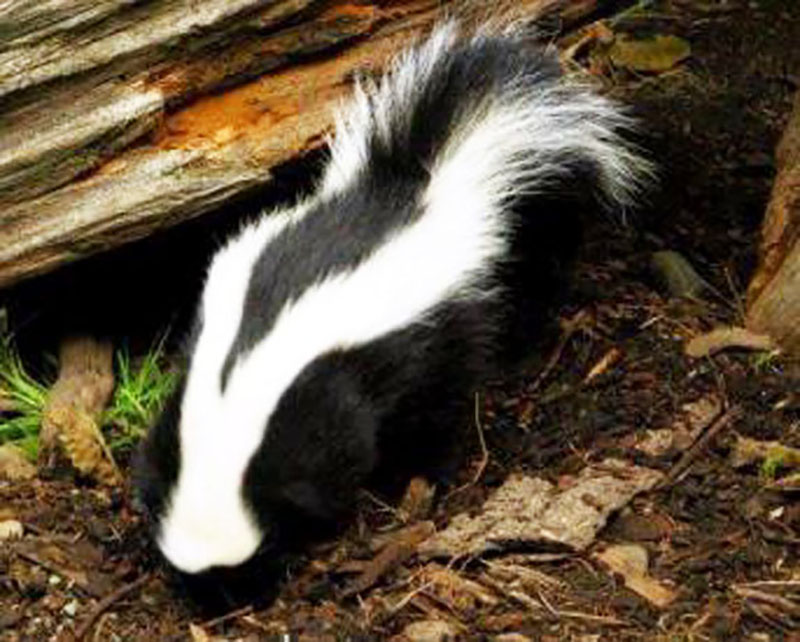RiskVA
Spring Stinkers – Skunks 18 Feb 2009
Wildflowers may be perfuming the spring breezes now, but fragrant skunks can also add their particular brand of aromatic fragrance.
These arrogant, furry, black and white mammals wander boldly through backyards, rifle through garbage and strut fearlessly across roads and highways, where they frequently end up as smelly pancakes. A skunk's scientific name, Mephitis mephitis, comes from Latin and means “poisonous vapor.” It’s not really toxic, but if you get sprayed, you may feel as though it was.
Striped skunks are our most frequently encountered variety. Plentiful throughout the United States, they roam largely unmolested, although Great-horned Owls hunt them, and foxes, hawks, coyotes, and dogs occasionally eat them. In my opinion, you gotta be REALLY hungry to do that!
In the great outdoors, skunks eat mostly insects, but spiders, snakes, small mammals, birds and their eggs, millipedes, and vegetation also add to their diet. Well adapted to living in and around communities, skunks supplement wild meals with choice selections from garbage cans.
Given the opportunity, calm skunks will usually walk away from an encounter with any animal, including humans, but surprised ones are another matter. They sometimes purr, growl, click their teeth, stomp their front feet, and do a handstand on their front legs to let their adversary know it’s time to back off. A stomping, growling, tooth-clicking skunk is a thing to behold, but only from a distance. Because if these performances fail, the agitated skunk will turn their rear end toward the attacker, raise their tail and become a little fuzzy four-footed pepper spray, squirting a smelly, irritating chemical mixture twelve feet or more. Plus, they’re good for 7 or 8 repeat shots if necessary, although most animals quickly get the message after the first blast.
Not only does skunk spray smell terrible to most animals, it also burns like crazy, and in the eyes, may cause temporary blindness. Incidentally a skunk’s musk is not in its urine, and they do not fling it with their tail. It squirts out of specialized anal glands. Nice huh?
Supposedly, a skunk can’t spray if you pick it up by its tail, but experts say that’s not necessarily true! Besides, I wonder how you get good at picking skunks up? The practice sessions must be murder.
Dog are not known for their intelligence around skunks and often get sprayed as payment for their curiosity. What do you do with a skunky dog? What if you get sprayed? Leaving the county for a prolonged vacation is recommended, but most folks you encounter along the way probably won’t be too hospitable! B&B is the answer – burn your clothes and bathe – thoroughly! Bathing in tomato juice can be an effective deodorizing method, and it also makes smelly dogs and cats a pretty pink. You can follow the tomato juice soak by rubbing a vanilla-moistened cloth on a sprayed pet so they end up looking and smelling a little like a hairy pink sugar cookie! Or you can mix a quart of hydrogen peroxide with ¼-cup baking soda and 1 teaspoon of liquid soap as a shampoo. There are also commercial deodorizing products available at pet stores.
Skunks, like many other mammals, can carry rabies, and one that appears disoriented or approaches you fearlessly ought to be suspect. If you are bitten by a skunk immediately wash the wound with soap and water and seek medical attention. If the offending stinker can’t be found, which is usually the case, rabies injections are usually administered. Five injections are given over the period of a month in the deltoid muscle in the upper part of the arm. The shots are not particularly painful, but the series of injections can cost from $1000 to $2000.
It is vital to remember that a bite victim must not wait to see if they get sick before seeking medical aid, because by then it is too late, and virtually without exception rabies victims showing symptoms die.
Skunks are interesting, but observe them at a distance – as though you really need to be told – and if possible, avoid running over them. The collision will surely kill them, but they’ll end up getting the last laugh when they anoint your car.
Dr. Risk is a professor emeritus in the College of Forestry and Agriculture at Stephen F. Austin State University in Nacogdoches, Texas. Content © Paul H. Risk, Ph.D. All rights reserved, except where otherwise noted. Click paulrisk2@gmail.com to send questions, comments, or request permission for use.

